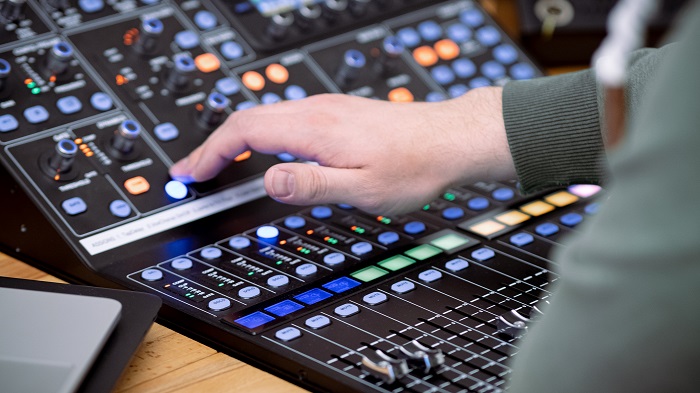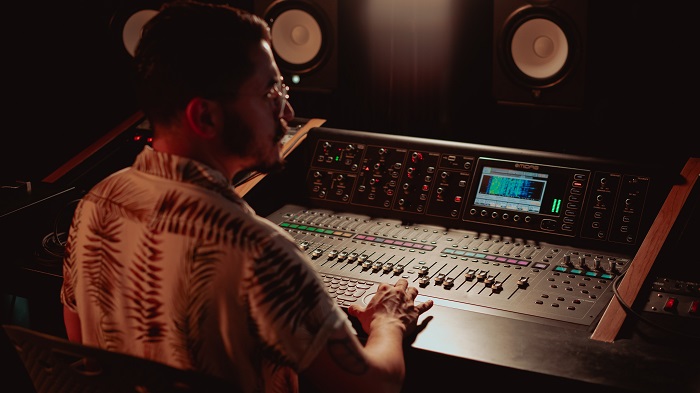You might’ve heard a song in a club, in a live performance, and on your car radio. In each case, the song seems to be quite different. To the point that you wonder whether the same performer actually did all of them.
A song like David Guetta’s Dangerous stage performance is way different from the studio release, despite the mixing and fine-tuning in the live production.
Mixing is a powerful tool in music that goes beyond the compilation of different tracks in one stereo track. It’s the magic wand that transforms regular tunes into unforgettable music. Read on to learn more about what is mixing in music.
Understanding What Is Mixing in Music
Mixing is the art of conditioning individual audio tracks and putting them in the best possible form. Then, fitting the tracks together, and finally bundling them in a single stereo track. This fully mixed track is ready for mastering.
A perfectly mixed track should give the experience of a live soundstage, where every instrument and every sound is visualized, not just heard.
The Audio Mixing Process in Simple Terms
Another way to describe the intent of mixing is to see it as a series of steps. A process that takes a raw audio recording and makes it a balanced, synced, and emotional piece of music.
The details of the process might seem a bit too complicated, with words like compression, phasing, gain, faders, and reverb flying about. But in reality, it’s easy to learn. The most important thing is to master the basic tools, so you can move on to developing your style.
Here’s a summary of the mixing process:
Step 1: Putting the Tracks in Good Order

Sound engineers often receive the tracks of a song in installments. This includes double recordings, empty tracks, noisy tracks, several versions of solos, and multiple vocals from the leads and chorus.
To start mixing, the first step would be a cleanup of these tracks, then putting them in good order. The following are some tried and true tips sound engineers use to streamline the work.
- Throwing away the dud tracks and duplicates.
- Arranging the good ones in groups.
- Color coding and re-labeling the tracks.
- Regrouping similar vocals or instruments and assigning them to busses.
Step 2: Setting the Initial Values
This is a prep stage that unifies the tracks and sets the tone of the song.
At this point, it’s essential to select a high buffer setting to increase the processing speed. Usually, a 1024 setting is good.
The first actual step in prepping the tracks is to enter the time signature as well as the tempo of the song. This is what a maestro would do in a concert to keep all the players in tune.
Next, comes the timing of fade-ins and fade-outs. This should be the same for all the tracks, and it’s often taken as 10 msec at both ends. Crossfades are a different story, and they’re often set at a subsequent stage.
A general gain alignment for all files is also done at this stage. This is to make sure that all the sounds are within a specific audio range. Usually, a bit of gain is added or reduced to keep the tracks between -30dBFS and -6 dBFS.
Step 3: Balancing the Volume
The volume of the individual tracks is among the factors that make or break a song. A well-balanced track is easy on the ear and brings out the beauty of every contributing sound. Simple tools usually go a long way!
This is carried out by first selecting the most important track. Then the ones a little less important, and so on.
Giving more punch to one track and making the ones around it less evident isn’t being unfair. It’s being artistic.
Step 3: Compression and Signal Conditioning

This is where things get pretty technical. Additionally, only a truly talented sound engineer can carry out signal conditioning in a satisfying manner.
At this stage, a sound engineer fine-tunes the gain, volume, attack time, release time, in addition to setting the final threshold, ratio, and makeup gain.
By the end, the music should take shape, but it would still sound odd and flat. That’s because the frequencies of individual tracks are all over the place. And this is why the next step is needed.
Step 4: Equalization (EQ)
The human ear can pick up sounds from 20 Hz to 20 kHz. The extreme ends are often too hard to listen to, with the range from 20-60 Hz labeled a Sub-Bass, and that from 8 kHz to 20 kHz known as ‘Highs’. These are frequencies most people avoid.
The rest of the range goes from Bass, Lower Mids, Mids, to Upper Mids. and these are often the attractive frequencies.
The EQ boosts a weak instrument or cools off a perky one by adjusting its frequency. This is done by choosing a suitable filtration process.
Step 5: Recreating the Sound Stage
A band, or even an orchestra, often takes specific places on the stage. And the sound coming from each instrument always has the feel of its source. Whether it’s coming from the right, left, center, front, or back, the audience can always tell.
By using panning, reverb, and delay to the tracks, the sound engineer can recreate that feel.
Step 6: Adding Effects
This is a bit like playing with the tracks to give them a glam factor. A uniqueness that sets a song apart from anything else.
It can be as simple as adding a bit of delay in an unexpected section, or as complicated as using digital samples for a more dramatic experience.
Step 7: Getting Ready for Shipping Off

The tracks are at this stage balanced, conditioned, equalized, and dramatized. The only thing remaining is to debug!
Typically, a sound engineer leaves the track for a few hours, then listens to them again from tip to toe. If anything sounds off, this is the last chance for correction.
Finally, the mixed tracks are transferred to a single bus that’s now ready for mastering.
Can You Make a Songbird Out of a Crow?
The mixing process is famous for adding richness, punch, and flair to otherwise flat tunes. Also, for smoothing out weaknesses and even hiding a fault here and there. But is it possible to transform a dud into a hit?
The answer is a big NO. Even the best audio engineers would be helpless in front of an off-key performance.
As for a noisy track that barely carries any useful signal, they could try to boost the meaningful parts of it and mute the distractions. However, the end result would still be discouraging.
Mixing is ultimately adding highlights to make a good thing better, and a promising tune sublime. Thus, correcting the occasional glitch is totally acceptable, as long as it’s a rare exception rather than a rule.
It’s best to work on recording higher quality tracks, instead of trying to iron out wrinkles.
What Are The Differences Between Mixing and Mastering?
Having taken a dozen tracks, cleaned them up, beautified them, matched them nicely, and aligned them in a single stereo track, the job seems to be all done. Or is it?
Actually, this mixed track is far from done. It’s just fully mixed and ready for the next stage of conditioning.
In fact, more often than not, the mixing engineer is different from the mastering engineer. They could even be working in two separate studios.

The main difference between mixing and mastering is that mixing focuses on a specific song, while mastering is often concerned with a whole album. The steps of mastering could be summarized as follows:
- Adding the final touches to a song or a collection of songs.
- Ensuring that all the songs have a main theme, character, and ‘feel’.
- Framing the special features of each song and making it stand out.
- Sequencing the songs to make them easy on the ear.
- Conditioning the format of the songs and getting them ready for distribution.
- Adding metadata to the tracks where necessary.
Would DJ-Mixing and Remixing Count as Music Mixing?
These two terms imply that there’s track mixing involved, but that’s only true in one case!
DJ-Mixing
DJ-mixing first appeared in the 1960s as Francis Grasso, who was a famous disc jockey at the time, decided to use records having the same tempo for a seamless audio experience. His beatmatching method later developed into mixing two songs together by syncing their beats.
In the olden days, this was done manually, but later on, tech stepped in. Whether it’s digital or analog record mixing, this is a very different story from the actual track mixing we’re talking about.
The DJs simply vary the tempo of a song to merge nicely with another song, hoping to keep the dancers on the stage for the longest possible time. Track mixing is a much more complicated process.
Remixing
As for remixing a song, that is actually a redo of the whole mixing and mastering process. Remixing involves adding effects, phasing, filtering, reverb, EQ, and all the rest of the mixing tools.
The goal is to recreate a song or score using a new perspective while maintaining the soul of the original. Thus, the best remixes are the ones that pay tribute to a familiar song but add the pulse of a new generation.
Can Beginners Do Music Mixing?

A few years ago, anyone would’ve answered: “Of course not!”.
The mixing process required tons of expensive gear that only professional studios could afford. Additionally, operating the multitude of audio control boards needed a sound engineer with huge experience.
However, in our beautiful times where everything is digitally available, beginners can definitely try their hands at the virtual mixing panels. They can obtain raw tracks from any digital audio workstation (DAW), and through MIDI-supported instruments, they can put together a rich compilation ready for mixing.
Every expert started as a curious novice, and that’s how we all learn. For any music enthusiast, there are many benefits to understanding the ins and outs of mixing. The biggest one is being able to produce a presentable song or score at a home studio.
Sending this polished product to potential buyers from the music industry is way better than sending them an amateurish recording. Luck works best for those who are well prepared.







